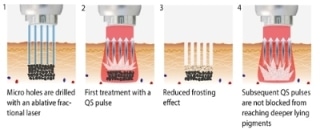Mar 7 2016
Fotona, based in the U.S. and Europe, announced that is has been granted a patent (US9254174) for its advanced FracTat™ Method for Lightening or Eradicating Pigments in Human Skin, in particular for pigmented skin lesions and tattoos.
 FracTat (TM) Procedure
FracTat (TM) Procedure
When lasers are used to remove tattoos, the laser pulse strikes the tattoo pigment creating gas and steam that is trapped within the skin. This causes optical shielding, commonly known as a "frosting" effect that prevents subsequent laser pulses from effectively reaching the deeper-lying pigments. Additionally, gas bubbles which are formed around the pigment particles can damage the surrounding tissue and cause scaring. The patented method avoids this effect by laser drilling fractional micro holes in the skin that act as pressure relief ducts through which the gases can escape without building up excessive pressure. The clinical benefits of using FracTat™ include enhanced generation of photoacoustic shockwaves, reduced frosting and pressure on the surrounding tissue, multiple nano or pico second laser treatments can be done during a single session and there is also direct pigment removal via the FracTat™ ablation and improved healing of fractioned skin.
In the embodiments of the patent, Fotona combines the benefits of fractionated skin resurfacing with the photoacoustic shattering of pigments with high peak powered lasers.
According to Mark Taylor, MD (a world renowned laser dermatologist and owner of one of the world's largest cosmetic laser centers, Gateway Aesthetic Institute and Laser Center, Salt Lake City, UT), "FracTat™, using the Fotona QX Max laser, has proven to be a very effective way to safely and quickly remove a wide range of tattoos when compared to other lasers. The fractional "chimneys" within the skin release gases and also ablates some of the tattoo ink giving me the ability to get more clearance in each treatment, faster overall clearance in fewer treatments and also to resolve deeper, stubborn, difficult to remove tattoos. In addition, the skin resurfacing improves skin texture and tone and also reduces any scarring resulting from when the tattoo was created."